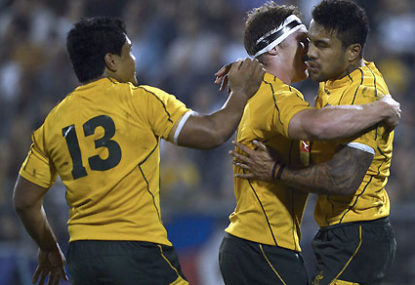Steve Hansen caused a fuss this week when he waded into the debate on player depth in Australian rugby.
The New Zealand coach was prompted after Aucklander Mike Harris kicked the Wallabies to a draw on Saturday night, and the Western Force signed All Black scrummy Alby Mathewson for next year’s Super Rugby season.
It is true that a number of New Zealand-born players have starred for the Wallabies in recent times – Quade Cooper, Sekope Kepu and Digby Ioane – and there are a stack more playing for Australian Super Rugby sides.
There’s also been a Wallabies few born in other countries – David Pocock, Radike Samo, Will Genia, for example.
It is also true that Australian rugby has never ever really been blessed with amazing depth, basically because its playing numbers have never matched those of New Zealand, South African or England.
Rugby league remains a big lure for many players, and the ARU must compete with the NRL, AFL and FFA for the most talented footballers in the country. Cricket is another strong competitor. The game they play in heaven sits in fourth or fifth place in this race.
However, according to the ARU’s figures, participation rates were up last year.
The debate about player depth has been exacerbated by the poor performance of Australia’s Super Rugby teams this year, and the introduction of the Melbourne Rebels. Our disappointing showing at this year’s Under-20 World Cup hasn’t helped either.
But just how accurate is Hansen? Is Australia pillaging the Shakey Isles?
Well, first of all, it pays to remember that there are around half a million Kiwis living in Australia at the moment. The migration of New Zealanders across the ditch, as well as Pacific Islanders, has become a flood in recent years.
Globalisation and better economic opportunities make Australia an attractive home. This won’t change anytime soon. It’s common sense that many of these migrants and their children will represent Australian in sport. While it’s unfortunate for New Zealand, it is a fact of modern life.
But New Zealand itself has benefited from migration trends, with countless players with Samoan, Fijian and Tongan blood starring in club rugby, the ITM Cup and Super Rugby.
New Zealand has long been the top exporter of rugby-playing talent around the globe – as the world champions and a place where rugby is a religion, expect this to continue in the future. Again, something that Hansen needs to learn to live with.
Right now there are 142 professional rugby players in Australia, comprising the first-choice teams of the five Super Rugby clubs, but not including their wider Academy/emerging squads or the Australian Sevens teams. Of this the vast majority are Australian or eligible to play for Australia.
But what about the 50 or so players plying their trade in leagues in Europe? Those playing on the fields of England, Ireland, Scotland, Wales and France rarely get mentioned or considered in this debate.
That number includes former Wallabies Matt Giteau, Luke Burgess, Dean Mumm, Huai Edmonds, Cameron Shepherd, Mark Chisholm, Morgan Turini, David Lyons, Justin Harrison and Josh Valentine, as well as former Super Rugby players such as Patrick Phibbs, Julian Salvi, Nic Berry, Daniel Halangahu, Pat O’Connor, Brock James, Ben Hand and Josh Holmes.
It also includes Australian-born Italy and Scotland reps Luke McLean and Dan Parks, and former Kangaroo Luke Rooney, but not those playing in Japan or elsewhere (USA, Canada etc).
You put those players, currently starring for Exeter, Leicester, Treviso, FC Grenoble, Stade Francais and other clubs, together and you would have a pretty handy Australia squad.
Sure, several of those players have moved to Europe because they are at the end of their careers. Others have been lured by fat contracts, a change of lifestyle or simply because they didn’t see an opportunity for themselves in Australia, which is fair enough.
But now with five Super Rugby franchises, the playing opportunities have increased significantly. With the Wallabies and Australian Super Rugby teams suffering this season what seems like a record injury-cloud, there has never been a better chance for a player to put himself in the green and gold shop window.
The reality is we need to do a better job of retaining our own talent and encourage those youngsters, produced on our shores, to stay home. We want them to play their best years in Australia and depart for overseas at the latter stage of their careers, if they decide to.
So, Steve Hansen has a point, but is not considering the whole picture. He is being shortsighted and should understand the wider factors at play here. Players will move where the greatest opportunity is.
Australia, and New Zealand, need to improve their development and recruitment strategies. Australian Super Rugby playing squads, as the likes of Ewen McKenzie have asked, should be extended. The introduction of a viable third tier, or an under-20s competition like the NRL’s Toyota Cup, is another idea that should be debated.
A review of player nationality eligibility in Super Rugby and the selection of overseas-based players for Test rugby, ala global football, may be warranted.
Player depth in Australian rugby is always going to be a struggle but there are solutions out there.





























































































